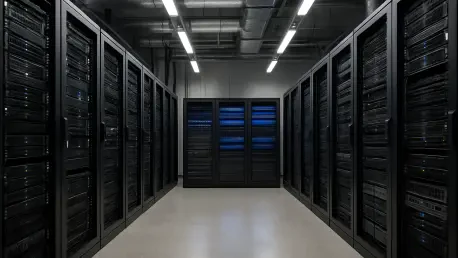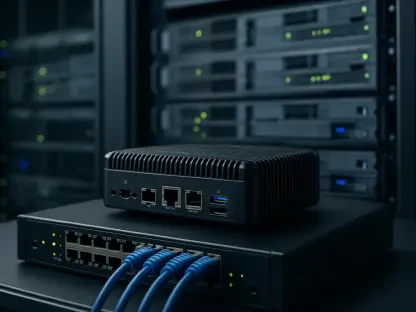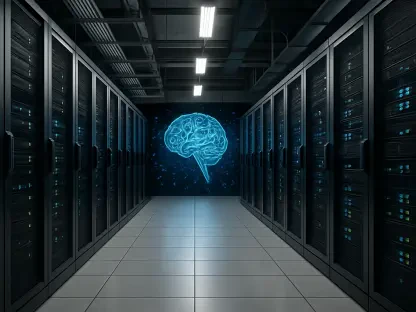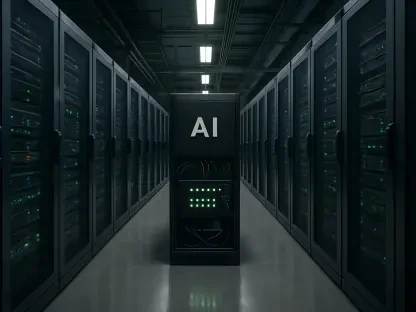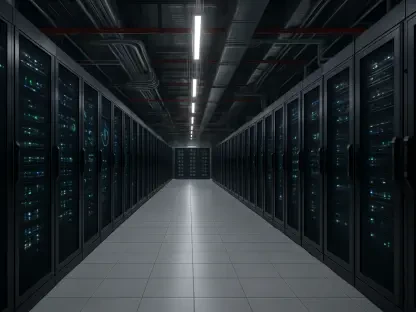In an era where artificial intelligence is reshaping industries at breakneck speed, data centers are struggling to keep pace with an unprecedented surge in demand, and it’s becoming increasingly clear that traditional infrastructure is buckling under the weight of these needs. Picture a sprawling network of servers humming under immense pressure, tasked with processing AI workloads that grow exponentially by the day. Hyperscalers and enterprises alike face a daunting reality: their systems are being pushed to the limit. This critical juncture in technology sets the stage for groundbreaking solutions, with Cisco stepping into the spotlight with innovations designed to redefine how data centers operate in this AI-driven landscape.
The significance of this story lies in the urgent need for scalable, efficient systems to support the AI revolution. As data centers grapple with limited physical space, soaring energy costs, and skyrocketing computational demands, Cisco’s latest advancements offer a lifeline. With new routing systems and chips tailored for distributed AI workloads, the company is addressing some of the most pressing challenges in the industry. This development isn’t just about keeping up—it’s about setting a new standard for what data centers can achieve in an increasingly complex digital world.
Why AI Data Centers Face Unprecedented Challenges
Data centers today are under siege from the relentless growth of AI applications, which demand extraordinary levels of processing power. Machine learning models, generative AI tools, and real-time analytics are pushing infrastructure beyond its limits, with workloads doubling in complexity every few years. This surge creates bottlenecks in performance, testing the boundaries of existing hardware and leaving many facilities on the brink of capacity.
Beyond sheer computational needs, physical constraints add another layer of difficulty. Urban areas, once ideal for data center hubs, now lack the space to accommodate the sprawling facilities required for hyperscale operations. Power consumption, too, has become a critical issue, with AI systems drawing massive amounts of electricity, driving operational costs through the roof and raising sustainability concerns among stakeholders.
These combined pressures signal a turning point for the industry. Without innovative approaches to scalability and efficiency, data centers risk becoming obsolete in the face of AI’s insatiable appetite. The stakes are high, and the need for transformative technology has never been more apparent, paving the way for solutions that can tackle these multifaceted challenges head-on.
The Broader Impact of AI on Data Center Evolution
AI isn’t just straining data centers—it’s fundamentally altering their design and location strategies. The hunger for computing power has sparked what industry experts call the “great data center migration,” a shift toward vast, affordable land far from urban centers. Hyperscale facilities now often require hundreds of acres, a resource scarce in metropolitan regions, forcing companies to rethink where and how they build.
This migration ties directly to escalating power costs and environmental considerations. AI workloads are notoriously energy-intensive, with some estimates suggesting that data centers account for up to 3% of global electricity usage—a figure projected to rise sharply by 2027. Balancing this demand with sustainable practices has become a priority, pushing the industry toward energy-efficient architectures and renewable energy integration.
Amid these trends, the role of technology providers becomes crucial. Solutions that enable distributed systems, reduce power draw, and adapt to spatial limitations are no longer optional but essential. This evolving landscape underscores why cutting-edge innovations are vital for ensuring data centers remain viable engines of the digital economy, setting a foundation for the next wave of progress.
Cisco’s Cutting-Edge Tech: Unveiling the 8223 Systems and P200 Chip
At the forefront of this transformation are Cisco’s newly launched 8223 routing systems and Silicon One P200 chip, engineered to meet the demands of AI workloads. The 8223 systems deliver a staggering 51.2 Tbps (terabits per second) capacity, setting a new benchmark for Ethernet routing in data centers. Meanwhile, the P200 chip offers interconnect bandwidth surpassing three exabits per second, ensuring seamless communication across sprawling networks.
A standout feature is the “scale-across” architecture, which allows AI clusters to be distributed over hundreds of miles. Unlike traditional scale-up or scale-out models confined to single locations, this approach addresses spatial and power constraints by linking multiple data centers into a cohesive system. Additional innovations, such as deep-buffer technology for managing network congestion and a reported 65% improvement in power efficiency, further distinguish these tools from previous generations.
The real-world impact is already evident among hyperscalers managing massive AI-driven tasks. For instance, a leading cloud provider could leverage this technology to distribute workloads across distant facilities, maintaining performance despite limited local resources. These advancements aren’t just incremental—they represent a paradigm shift in how data centers can operate at scale, offering tangible solutions to pressing industry pain points.
Industry Voices Weigh in on Cisco’s Bold Strategy
The response to Cisco’s innovations reveals a mix of admiration and debate among industry insiders. Ron Westfall, a networking analyst at HyperFrame Research, highlights the spatial challenges driving the need for distributed systems, noting that “the era of cramming everything into one urban data center is over—scale-across is the future.” His perspective underscores the urgency of adapting to real estate limitations in the AI age.
Semeh Boujelbene of Dell’Oro Group praises the deep-buffer design in Cisco’s systems, arguing that it provides a critical safety net against network failures by holding larger data packets during congestion. However, not all feedback is unanimous—competitors like Nvidia raise concerns about potential latency issues with deep buffers, advocating for alternative approaches to maintain speed. This tension reflects a broader industry discussion on balancing reliability with performance.
Cisco’s own Rakesh Chopra, a senior vice president for hardware, remains confident in the company’s direction, asserting that no rival currently matches the 51.2 Tbps capacity or achieves comparable power savings. These diverse viewpoints paint a picture of a dynamic field where innovation sparks both collaboration and contention, positioning Cisco’s strategy as a focal point in shaping data center standards.
Practical Applications: Leveraging Cisco’s Tech for Modern Challenges
For hyperscalers and enterprise IT leaders, integrating Cisco’s technology offers a clear path to overcoming today’s data center hurdles. Adopting a distributed architecture through the scale-across model enables organizations to bypass physical limitations by spreading workloads across multiple sites. This strategy ensures operational continuity even when local space or power resources are constrained, a common issue in densely populated regions.
Energy efficiency stands out as another actionable focus. By prioritizing systems with a 65% reduction in power consumption, companies can slash operational costs and align with sustainability goals—an increasingly important metric for stakeholders. Implementing such solutions not only addresses immediate budgetary concerns but also positions firms as responsible players in a power-hungry industry.
Finally, stability during peak demand can be achieved through deep-buffer technology, which mitigates the risk of network failures. IT leaders can integrate this feature to maintain service quality, especially during high-traffic periods driven by AI applications. These practical steps, tailored to current needs, empower organizations to stay competitive in a rapidly evolving technological landscape, ensuring they are equipped for the challenges ahead.
Reflecting on a Game-Changing Leap
Looking back, Cisco’s introduction of the 8223 routing systems and Silicon One P200 chip stood as a defining moment in the evolution of AI data centers. These innovations tackled critical issues of scalability, power efficiency, and network stability with unprecedented precision. The ability to distribute workloads across vast distances while maintaining performance reshaped how hyperscalers and enterprises approached infrastructure challenges.
The industry took note of the significant strides made in energy savings, a vital step toward sustainable operations amid rising electricity demands. Debates around design choices, such as deep buffers, highlighted the complexity of optimizing for both speed and reliability, yet Cisco’s comprehensive focus on capacity and security set a high bar for competitors. This period marked a shift toward distributed systems as a cornerstone of modern data center strategy.
Moving forward, organizations were encouraged to explore how such technologies could be tailored to their unique needs, whether through pilot programs or phased integrations. Industry leaders were urged to collaborate on refining these solutions, addressing lingering concerns like latency while pushing for even greater efficiency. This chapter in tech history laid the groundwork for a future where data centers could fully harness AI’s potential, inspiring continued innovation and adaptation in the years that followed.
